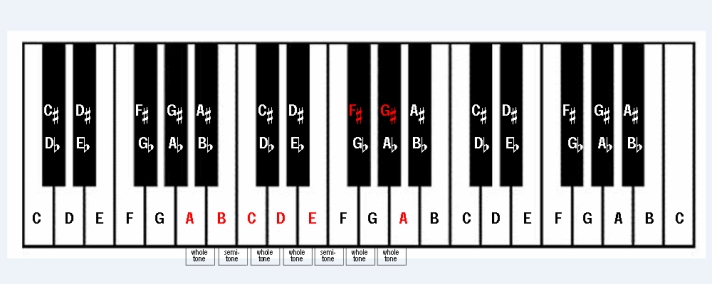Melodic Minor Scales
I like to think of the melodic minor scale as the chameleon scale as it changes its colours. The ascending scale creates more tension by sharpening the sixth and seventh steps, and the descending scale relaxes that tension by flattening the seventh and sixth steps. The sequence of intervals for the ascending scale of A melodic minor is as follows:
Step 1 – 2 (a – b): whole tone
Step 2 – 3 (b – c): semitone
Step 3 – 4 (c – d): whole tone
Step 4 – 5 (d – e): whole tone
Step 5 – 6 (e – f#) whole tone
Step 6 – 7 (f# – g#) whole tone
Step 7 – 8 (g# – a) semitone
The descending half of the melodic minor scale is identical to that of the natural minor scale:
Step 8 – 7 (a – g) whole tone
Step 7 – 6 (g – f) whole tone
Step 6 – 5 (f – e) semitone
Step 5 – 4 (e – d) whole tone
Step 4 – 3 (d – c) whole tone
Step 3 – 2 (c – b) semitone
Step 2 – 1 (b – a) whole tone
So the ascending scale shares its first five steps with the natural and harmonic minor scales, and its sixth to eighth steps with its major counterpart (note: the major key with the same keynote and NOT the relative major). As already mentioned, the descending melodic minor scale is identical to the descending natural minor scale. We now know that harmonic minor scales form the harmonic basis of minor keys, so it stands to reason (and the name suggests) that melodic minor scales form the melodic basis. The raised sixth step prevents the dissonant augmented second interval found in harmonic minor scales and the raised seventh provides a strong resolution from a leading tone to the tonic. Since descending passages don’t require the tension and definition provided by a leading tone, the descending melodic minor offers a sound truer to the overall minor structure.
The diagram below shows the structure of A melodic minor ascending on the keyboard:
Here’s a video diagram showing the lowest octave of A melodic minor ascending and descending on the cello.
